Invisalign® – Tulsa, OK
Creating a Straighter Smile More Discreetly
It can be tough going through life with crooked or gapped teeth. You may struggle with a misaligned bite that is wreaking havoc on your jaw, causing much pain. When teeth do not properly align or function as they should, you may wonder if you’ll ever be able to enjoy a healthy, aesthetically pleasing smile. The good news is that you can with Invisalign in Tulsa! At My Dentist Midtown, our team offers a safe and effective alternative to traditional braces that produces the same great results in less time. If you’re interested in learning more about Invisalign, call our office to schedule an appointment.
Why Choose My Dentist Midtown for Invisalign®?
- Dentist Who is Certified in Invisalign
- Digital Impression System for Less Mess
- We Welcome Your Dental Insurance
How Does Invisalign® Work?
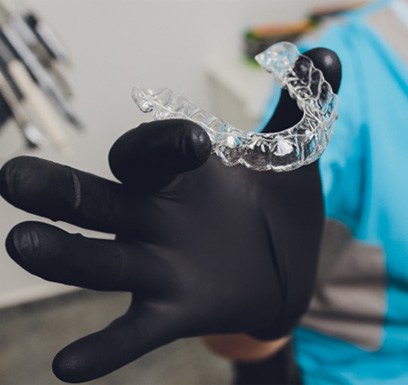
Invisalign clear aligners are designed to be worn for 20-22 hours each day. These customized trays are created using digital impressions of your mouth, which will we capture in-house before sending them off to lab technicians to create. Discreet and subtle because of their transparency, many patients are pleased with their ability to undergo treatment without bringing attention to it.
The materials used to create your aligners encourages teeth to shift by applying just enough continuous pressure on them. Over time, as you swap out your trays every 1-2 weeks, your teeth will move closer to their desired location. Depending on the severity of your dental problems when you start treatment, the average timeframe for completion is between 12-18 months.
Who Can Invisalign Help?

Knowing whether you require Invisalign should start with a scheduled consultation with a member of our team. We will work to identify if the problems you’re experiencing can be fixed using clear aligners. Here are some of the most common problems Invisalign is known to treat.
Crowded Teeth

When a lack of space exists between teeth, you will discover the difficulties that come with attempting to clean your smile. Not only does the floss snag when trying to thread it through, but brushing is unable to reach these crevices that are continuing to harbor bad oral bacteria. With Invisalign, though, we can design a plan to move teeth so that ample space is created without resulting in a gap.
Gaps Between Teeth

While Invisalign can work to create more space, it can also close them if too much of a gap exists. Bad bacteria and food debris can become trapped in these areas if left untreated, and gum disease and cavities are often the results. With Invisalign, these trays will bring teeth closer together to help you feel more confident in your appearance as well as enjoy a healthier smile.
Overbite
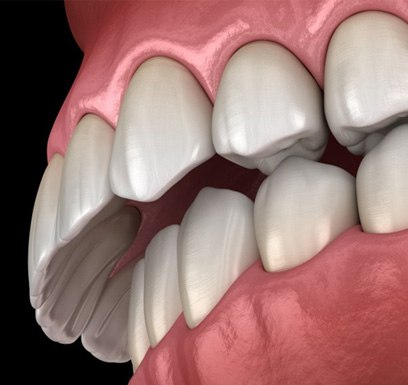
For some people, the upper teeth can grow to stick out too far from the lower set. Although a small degree of an overbite is natural, having too large of a space between the two gum lines can lead to complications like jaw discomfort, uneven teeth wear, and speech issues. With Invisalign, as well as the help of other appliances such as elastic bands, our team can help gradually move your jaws into proper alignment.
Underbite
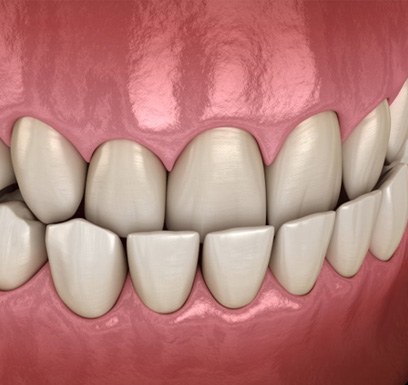
The opposite of an overbite can also happen, which is when the lower set of teeth jut too far out from the upper arch. This can typically be due to factors like genetics, trauma, and childhood oral habits, such as thumb-sucking. If left unchecked, an underbite can result in problems like mouth breathing, chronic bad breath, difficulty chewing, and sleep apnea. Depending on your situation, our team may be able to adjust your lower jaw by using Invisalign along with elastic bands and/or other attachments.
Crossbite
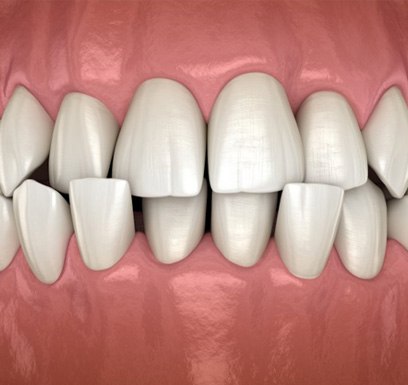
Sometimes a person’s teeth can grow out in various angles, making some of the bottom ones sit right in front of their upper counterpart. This condition can either be a front or back crossbite, depending on how your smile looks. Invisalign aligners can help shift the bottom teeth so that they aren’t sticking out further than the upper ones. If your situation is caused by a jaw development problem, then we might have to pair Invisalign with other services.
Open Bite
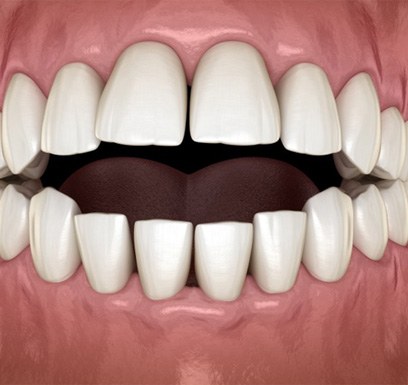
Those who cannot touch their upper and bottom teeth together when biting down have an open bite. This condition is not as common as the others, but it can lead to complications with both your oral and physical health, such as enamel wear, an increased chance of chipping, and speech/enunciation difficulties. By wearing Invisalign aligners, you can gradually correct your open bite by moving the two arches of teeth into the proper position. In time, you can expect an ideal bite pattern and boosted confidence.
The Benefits of Invisalign®
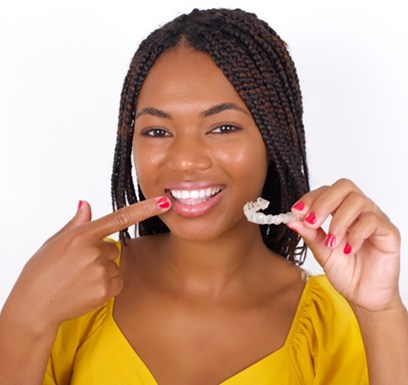
If you compare traditional braces to Invisalign, you’ll quickly discover the only thing that these two treatment options have in common is their ability to straighten smiles. Otherwise, the benefits that come from Invisalign are why so many patients are turning to them! Our team can help go over the unique advantages of choosing clear aligners over braces during your consultation. We’ve also included a brief overview below to encourage you to take the first step of the process and schedule a consultation with us!
Comfortable Trays
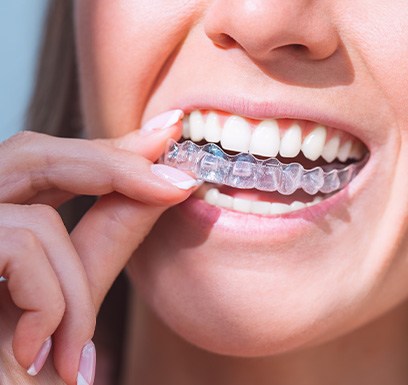
Unlike traditional metal brackets and wires that create friction and can become snagged on the inside of your lips and cheeks, clear aligners are made from smooth plastic. This means you won’t need to worry about carrying orthodontic wax on you all the time because they won’t damage your soft oral tissues.
Discreet Appearance

When you smile, you won’t have to worry about metal being the first thing that people notice. Clear aligners are very discreet. In most cases, onlookers won’t even be able to tell that you’re undergoing orthodontic treatment!
Better Dental Hygiene
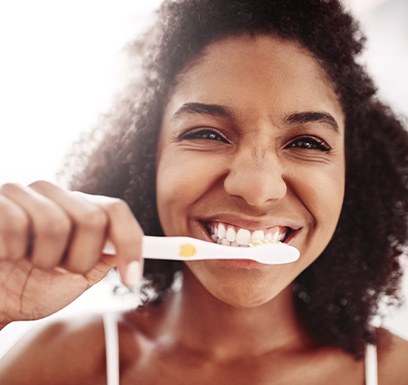
Having to floss and brush around brackets and wires can be difficult and leave room for error, allowing plaque, tartar, and food debris to build-up in hard-to-reach areas. When it comes to brushing and flossing during Invisalign treatment, all you’ll need to do is remove your trays and complete your oral hygiene routine like you normally do. This can allow you to avoid developing cavities during treatment.
Fast Follow-Up Appointments
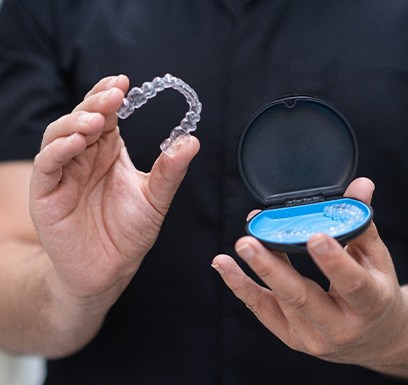
Your routine check-in appointments with our team at My Dentist Midtown can be scheduled during lunch breaks—they’re that short! Our team will quickly examine your mouth and make sure your aligners are working as they’re intended to. Then, we’ll send you on your way with the next series of trays in your treatment. Typically, we ask our patients to come in every six to eight weeks.
Boosted Confidence

Due to Invisalign clear aligners’ discreet appearance, teens and adults alike are able to maintain their unique sense of self and expression as they straighten their smiles. In many cases, people who see your smile won’t be able to tell that you’re undergoing treatment unless you point it out yourself!
Minimal Lifestyle Changes

Because clear aligners are removable and discreet, treatment is a breeze. You won’t have to worry about limiting the foods you eat or buy new oral hygiene tools to clean around brackets and wires. Simply remove your trays while you’re brushing your teeth or eating dinner or a snack. Then, brush your teeth, rinse your aligners, and put them back in your mouth when you’re done!
Living with Invisalign Aligners
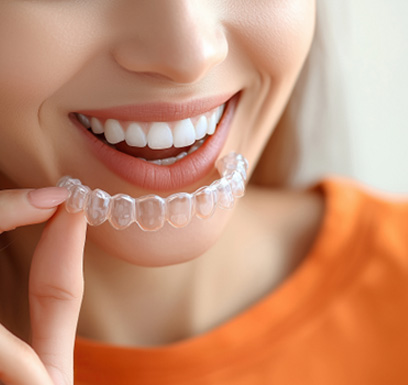
One of the biggest selling points of Invisalign is that it is designed to fit in with modern lifestyles. Although you will need to make some minor adjustments to your habits in order for your treatment to succeed, it should be very easy overall to integrate your aligners into your normal routine. Our team will be happy to coach you on how you can get the most out of Invisalign. In the meantime, here are some general tips for making a success out of this innovative treatment:
Wearing Your Trays

Remember that your Invisalign aligners only work when you are wearing them. Therefore, you should keep them in your mouth as much as possible (20 – 22 hours a day is the standard recommendation). Failure to do so could slow down your progress and even interfere with the way successive aligners in your series fit on your teeth. As a general rule of thumb, you should only remove your aligners when you eat, drink anything other than water, and care for your oral hygiene.
Cleaning Your Aligners
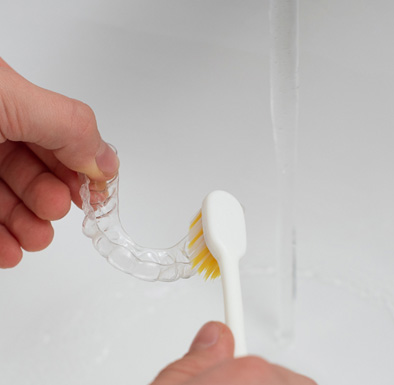
Keeping your aligners clean can protect them from odors and stains, and it can reduce the risk of damage to your oral tissues. You should:
- Thoroughly rinse your aligners before placing them in your mouth.
- Brush your aligners daily with a soft brush and mild, clear soap.
- Use only cool or lukewarm water to clean your aligners (high temperatures could warp them).
- Regularly soak your aligners in a cleansing solution. (Many patients use Invisalign cleaning crystals for this purpose.)
Eating & Drinking

Unlike braces, Invisalign does not come with any strict dietary limitations. However, you may need to adjust some of your eating and drinking habits.
- You should never eat or drink anything besides plain water while wearing your aligners. Doing so may cause them to become discolored or warped.
- Remove your trays at mealtimes and place them in their protective case.
- Try not to snack too often. Instead, get most of your calories from your three main meals so you do not frequently have to remove your aligner trays.
Losing or Damaging a Tray
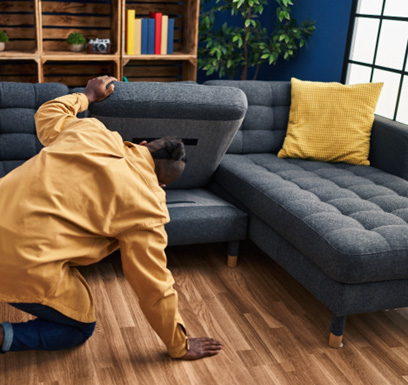
Accidents happen. If you ever damage or lose a tray, call our team. We might advise you to do one of two things:
- Go back to wearing a previous aligner. It can prevent your teeth from slipping too far out of place as you wait for a replacement for the aligner that is no longer usable.
- Move on to a new aligner a bit early. You should not do this without our explicit go-ahead. Moving ahead too early could cause significant discomfort.
Routine Check-Ins
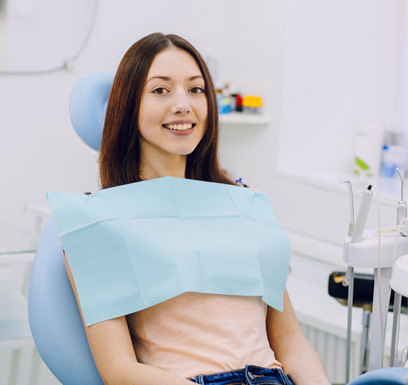
Every 4 – 8 weeks or so, our team will schedule you for a check-in appointment. These visits tend to be brief, often lasting 15 – 30 minutes or so. We will check your progress, provide you with the next set of aligners in your series, and strive to address any issues that may have arisen since your last appointment.
Understanding the Cost of Invisalign
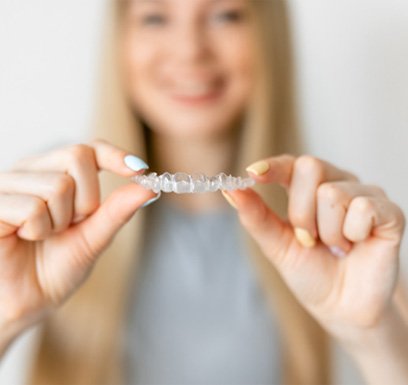
When meeting with a member of our My Dentist Midtown dental team, you can expect that not only will we go over your treatment plan, but we’ll also discuss the cost. You might think it’s simply not affordable, but it is! Whether you file with your dental insurance company for partial coverage or enroll in flexible financing through CareCredit, you can easily straighten your teeth without the worries or fears that come with the financial side of dentistry. To learn more on the topic – from the factors that impact the cost to how to make Invisalign more affordable – read on.
Factors That Affect the Cost of Invisalign
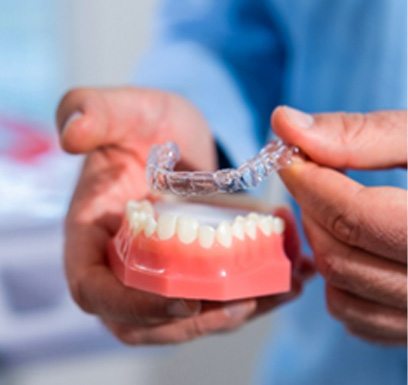
Since each treatment plan is 100% unique, the cost of Invisalign in Tulsa naturally varies. During your initial consultation, we will conduct an oral exam and ask you a few questions to determine:
- How severe your misalignment is
- How many trays are needed to achieve your smile goals
- If additional accessories, like rubber bands, are needed
It’s important to note that there is another factor that comes into play after you begin treatment: your compliance with the Invisalign guidelines. Bad habits like wearing your aligners for less than 20 hours a day can cause you to fall off-track with your treatment plan. Ultimately, this can result in you investing more time and money into your teeth-straightening journey.
Invisalign vs. Smile Direct Club™: Which Costs More?
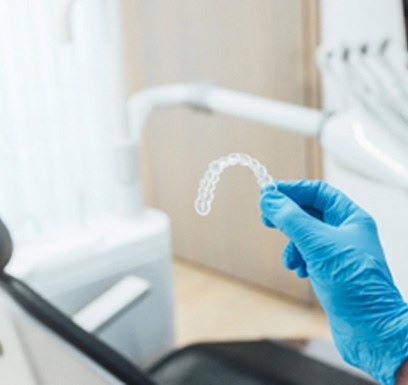
Mail-order aligner companies focus their marketing on the lower upfront cost. While this may initially sound like a perk, the question you should ask yourself is, “How?” To provide patients with a low price, they cut out crucial steps of the orthodontic process, including the initial exam to determine if you’re a candidate. Plus, they rely on DIY impressions, which are usually inaccurate and can result in numerous complications. Lastly, and perhaps most importantly, there are countless cases of patients who have experienced worsened misalignment, which is stressful to deal with and costly to correct. In short, mail-order options often end up being significantly more costly than patients first expect.
Does Dental Insurance Cover Invisalign?
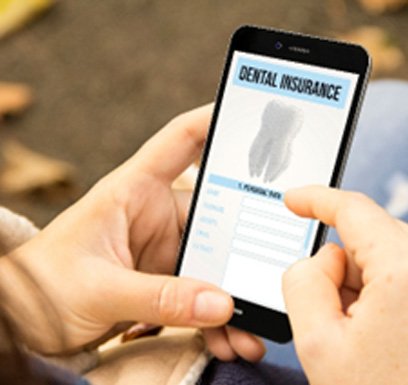
Dental insurance typically only covers treatments that are medically necessary. With that said, some plans do include a once-in-a-lifetime benefit for orthodontic treatment. So, it’s worth double-checking the fine print on your plan to see if your provider will cover a portion of the cost of Invisalign! We’re proud to be in-network with Delta Dental, Aetna, Humana, MetLife, and several others. So, if you have a question about your coverage, don’t hesitate to ask!
Options for Making Invisalign Affordable
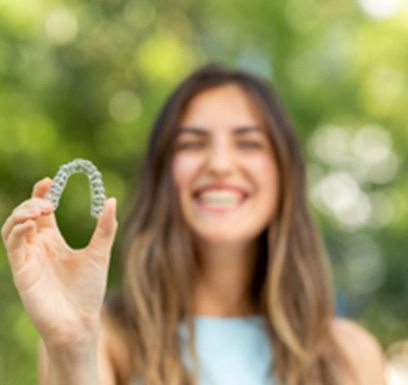
Fortunately, dental insurance isn’t the only option. For patients who are interested in Invisalign, but don’t want to pay for their entire treatment upfront, flexible financing may be the solution you’ve been looking for! CareCredit is a trusted third-party financier that’s helped millions of patients get the dental care they need without breaking the bank. There are several payment plans to choose from, and it only takes a few clicks to sign up!
Invisalign FAQs
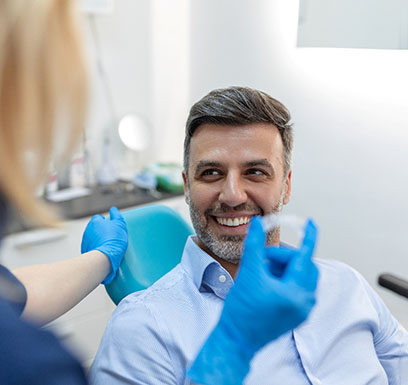
Invisalign requires an investment of both your time and money, so it’s only natural to have questions about the treatment process before you begin. Although our Tulsa dentist would be more than happy to provide you with the answers you’re looking for at your consultation, you can also read on to learn the answers to a few of the most frequently asked questions we get about Invisalign right here!
How Long Does Invisalign Take?
Although the average Invisalign treatment is between 12 and 18 months, there are several factors that impact the answer. One of them is the severity of your misalignment since this impacts how many trays you need, if additional accessories (like rubber bands) are required, and more. Another factor is your compliance with your treatment plan. If you don’t wear your aligners for 20-22 hours a day, you don’t clean your trays properly, or you skip your check-in appointments, then there is a good chance you’ll fall off-track with your treatment, adding more time to the back end of it.
Does Invisalign Hurt?
Good news: Invisalign is significantly more comfortable than traditional braces! Instead of metal brackets and wires, the trays are crafted from smooth, high-quality plastic. Plus, each aligner is custom-made just for you, which helps prevent irritation to your tongue, lips, and the soft tissue in your mouth. Of course, if you do experience some discomfort from your teeth moving, there are a few effective solutions, including taking an over-the-counter pain reliever, placing a cold compress against the outside of your cheek, and avoiding hard and crunchy foods.
How Do I Clean My Invisalign?
As previously mentioned, cleaning your aligners incorrectly can cause you to fall off-track with your treatment plan. That’s why it’s of the utmost importance that you avoid mistakes like using hot water or harsh cleaners, like bleach. Instead, keep it simple; rinse your aligners with room temperature water, use a soft-bristled toothbrush to clean each surface, and give them one final rinse.
Note: if your aligners are beginning to discolor there are a few things you can do. First, don’t eat or drink anything other than water with your trays in. Second, brush your teeth (and your aligners!) after each meal. Third, use a packet of cleaning crystals and some lukewarm water to soak your trays for 15 minutes or so.
Does Invisalign Give You a Lisp?
There is a common misconception that Invisalign will give you a lisp. However, the large majority of patients don’t experience any changes to their speaking patterns. Furthermore, the patients that do experience a slight learning curve can have peace of mind knowing it’s temporary. If you do have a slight change to your speech, then the best thing to do is practice, practice, practice. Try reading a book or magazine out loud and repeating any difficult words you come across until they sound natural.
What Do Invisalign Aligners Look Like When Worn?
Invisalign aligners are made out of a transparent plastic. As a result, they are virtually undetectable when worn over the teeth. If someone doesn’t already know that you’re wearing clear aligners, they will be very unlikely to notice them. This is a major reason why so many people prefer Invisalign over traditional braces.
It should be noted that clear aligners can potentially become stained or otherwise discolored, which can make them much more visible when worn. Luckily, this is a problem that you can avoid with proper maintenance, so don’t forget to clean your aligners thoroughly on a regular basis.
Will I Need Invisalign Attachments?
Depending on the nature of your orthodontic issues, attachments might be required to help your clear aligners make the necessary changes to the teeth. Attachments are small bumps that are placed on the teeth to act as anchor points, ensuring that the force of the aligners is directed at the right areas. This is often done for patients who are in need of more complex tooth movements.
Our team will let you know whether attachments will be part of your Invisalign treatment plan. We’ll also explain how many attachments will be used based on the specifics of your situation. Note that this number could potentially change during your treatment if your teeth don’t move as expected.
Who is Not Eligible for Invisalign?
While Invisalign can be an excellent option for patients who want to achieve straighter smiles, it is not recommended for the following groups:
- Younger Children: It’s generally best for your child to wait to start Invisalign treatment until most of their permanent teeth have erupted, which usually happens around the age of 13 years old.
- People with Severely Misaligned Bites: Invisalign is better for correcting mild to moderate bite issues. Particularly severe cases often call for traditional braces.
- People with Extra Small or Worn-Down Teeth: If your teeth are too small or significantly worn down, Invisalign aligners may not fit as they should.
To find out whether you’re eligible for Invisalign, you will need to schedule a consultation with our team. We’ll take a look at your mouth and consider your unique situation before making any recommendations.
What Should I Do If My Invisalign Aligner Broke?
In the event that your Invisalign aligner becomes damaged in some way, call our office immediately so that we can advise you on what to do next. Depending on how long you’ve been wearing the aligner in question, you may be able to switch to the next one in the series ahead of time. Otherwise, it may be necessary to wear a previous aligner until your dentist can provide you with a new one.
Remember, you should never attempt to fix a damaged aligner on your own. Not only could this make the damage worse, but it could also put the health of your smile at risk if toxic substances are used for repairs.

